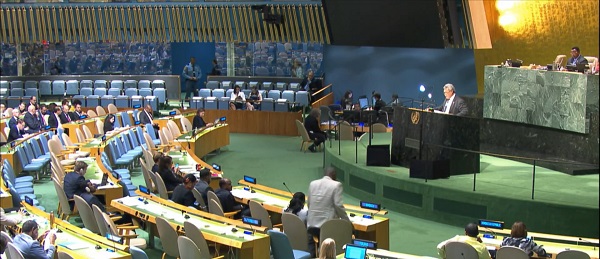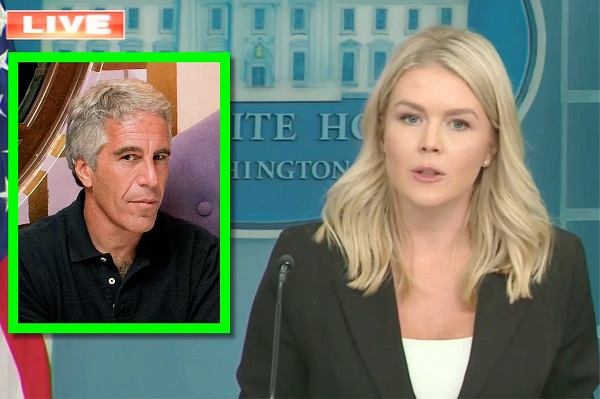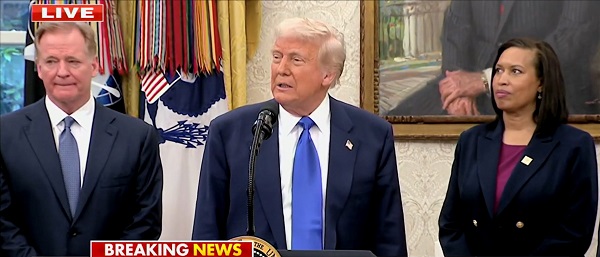Daily Caller
CIA Agents Posing As State Department Officials Outnumbered Real Ones, JFK Doc Shows


From the Daily Caller News Foundation
By Emily Kopp
Several foreign embassies housed more Central Intelligence Agency (CIA) agents posing as genuine State Department officials between 1950 to 1960, according to a document found in the more than 63,000 pages relating to former President John F. Kennedy’s assassination, released to the public by the Trump administration Tuesday evening.
CIA mission chiefs under diplomatic cover sometimes wielded more influence than the ambassadors, even advocating policies in conflict with official U.S. diplomacy, according to a June 10, 1961, memo. Kennedy was warned by historian Arthur Schlessinger Jr. in the document that CIA agents posing as State Department officials — so-called “Controlled American Sources” (CAS) — risked delegitimizing U.S. diplomacy.
“The effect is to further CIA encroachment on the traditional functions of State,” he wrote.
The CIA mission chief often exerted more power than the top diplomats, sometimes to conflicting ends, he said.
“On the day of President Kennedy’s inauguration, 47 percent of the political offices serving in United States Embassies were CAS,” the memo reads. “Sometimes the CIA mission chief had been in the country longer, has more money at his disposal, wields more influence (and is abler) than the Ambassador. Often he has direct access to the Prime Minister. Sometimes (as during a critical period [unreadable]) he pursues a different policy from that of the Ambassador. And he generally well known locally as the CIA representative.” (RELATED: Trump Administration Releases JFK Assassination Files)
Schlessinger’s 1961 memo to the president about the CIA — in which he advocated for a reorganization of the agency — had been of interest to historians and independent researchers as a Rosetta stone for understanding hostility between the former president and the nation’s foreign intelligence gathering services.
One section of the memo, however, spanning roughly 1.5 pages, remained redacted and was only revealed Tuesday night. The section described the CIA’s widespread use of diplomatic cover and its risks. Diplomatic cover was less expensive than other methods, quicker, and more attractive for agents, the memo states.
It’s unclear why the information has been concealed from the public for decades.
Director of National Intelligence Tulsi Gabbard praised the release of some 2,182 files related to the Kennedy presidency Tuesday and signaled that more documents could be released upon being released from court seal.
“President Trump is ushering in a new era of maximum transparency,” she said in a statement.
Schlessinger listed the number of CIA agents or “CAS personnel” populating embassies abroad.
“In the American embassy in Vienna, out of 20 persons listed in the October 1960 Foreign Service List as being in the Political Section, 16 are CAS personnel; of the 31 officers listed as engaging in political activities, over half are CAS,” he wrote. “Of the 13 officers listed in the political section of our embassy in Chile, 11 are CAS.”
Schlessinger expressed concern about the CIA’s dominance in the U.S. Embassy in Paris.
“In the Paris embassy today, there are 123 CIA people. CIA [in Paris] has long since begun to move into areas of political reporting typically occupied by State. The CIA men doing overt internal political reporting outnumber those in the Embassy’s political section by 18-2. CIA has even sought to monopolize contact with certain French political personalities, among them the President of the National Assembly,” he said.
The memo makes apparent reference to rumored CIA backing of the April 1961 Algiers putsch, in which generals unsuccessfully attempted a coup d’etat in French Algeria. French President Charles de Gaulle was moving Algeria toward self-determination and away from French control, which the generals opposed.
“CIA occupies the top floor of the Paris embassy, a fact well known locally; and on the night of the Generals’ [unreadable] in Algeria, passersby noted with amusement that the top floor was ablaze with lights,” he wrote. “I am informed that Ambassador Gavin was able to secure entrance that night to the CIA offices only with difficulty.”
Jefferson Morley, vice president of the Mary Ferrell Foundation and a longtime advocate for declassification, had identified this redaction section of the memo as among his top priorities ahead of the new release.
Schlessinger suggested a review of policies instituted around Jan. 19, 1961 — the day before Kennedy’s inauguration. The historian had warned Kennedy about so-called “controlled American sources” becoming a permanent feature of the foreign service, while also advocating for the “steady reduction” of CIA agents at U.S. embassies.
“Before State loses control of more and more of its presumed overseas personnel, and before CAS becomes permanently integrated into the Foreign Service, it would seem important (a) to secure every ambassador the firm control over the local CAS station nominally promised in the [unreadable] Directive of January 19, 1961, and (b) to review the current CAS direction with an eye to a steady reduction of CAS personnel,” he wrote.
The degree to which diplomatic cover for CIA agents remains a threat to the State Department’s independence and legitimacy also remains unclear. A New York Times story on March 6 about the shuttering of some foreign embassies noted that the prospect of further cuts had “generated some anxiety within the Central Intelligence Agency.”
“The vast majority of undercover American intelligence officers work out of embassies and consulates, posing as diplomats, and the closure of diplomatic posts would reduce the C.I.A.’s options for where to position its spies,” the paper reported.
Crime
‘We’re Going To Lose’: Steve Bannon Warns Withholding Epstein Files Would Doom GOP


From the Daily Caller News Foundation
By Jason Cohen
Former White House adviser Steve Bannon warned on Friday that Republicans would suffer major losses if President Donald Trump’s administration does not move to release documents related to deceased pedophile Jeffrey Epstein’s crimes and associations.
Axios reported on Sunday that a two-page memo showed the Department Of Justice (DOJ) and FBI found no evidence Epstein kept a “client list” or was murdered, but public doubts have continued. Bannon said on “Bannon’s War Room” that failure to release information would lead to the dissipation of one-tenth of the Make America Great Again (MAGA) movement and significant losses for the Republican Party in the 2026 midterms and the 2028 presidential election.
Dear Readers:
As a nonprofit, we are dependent on the generosity of our readers.
Please consider making a small donation of any amount here.
Thank you!
“It’s not about just a pedophile ring and all that, it’s about who governs us, right? And that’s why it’s not going to go away … For this to go away, you’re going to lose 10% of the MAGA movement,” Bannon said. “If we lose 10% of the MAGA movement right now, we’re going to lose 40 seats in ’26, we’re going to lose the [presidency]. They don’t even have to steal it, which they’re going to try to do in ’28, because they’re going to sit there and they go, ‘They’ve disheartened the hardest-core populist nationalists’ — that’s always been who governs us.”
Bannon also demanded the publication of all the Epstein documents on “Bannon’s War Room” Thursday. He called on the DOJ to go to court and push for the release of the documents or for Trump to appoint a special counsel to manage the publication.
Epstein was arrested in 2019 and charged with sex trafficking. Shortly after, he was found dead in his New York Metropolitan Correctional Center cell shortly after. Officials asserted that he hanged himself in his cell.
However, Epstein’s death has sparked years of theories because of the malfunctioning of prison cameras, along with guards admitting to falsifying documents about checking on the then-inmate. The DOJ inspector general later confirmed that multiple surveillance cameras outside of his cell were inoperable, while others captured the common area outside his door.
Both Bannon and Daily Caller News Foundation co-founder Tucker Carlson have speculated that Epstein had connections to intelligence agencies.
Former Labor Secretary Alex Acosta allegedly indicated that Epstein was tied to intelligence, according to Vicky Ward in The Daily Beast.
Business
UN’s ‘Plastics Treaty’ Sports A Junk Science Wrapper


From the Daily Caller News Foundation
By Craig Rucker
According to a study in Science Advances, over 90% of ocean plastic comes from just 10 rivers, eight of which are in Asia. The United States, by contrast, contributes less than 1%. Yet Pew treats all nations as equally responsible, promoting one-size-fits-all policies that fail to address the real source of the issue.
Just as people were beginning to breathe a sigh of relief thanks to the Trump administration’s rollback of onerous climate policies, the United Nations is set to finalize a legally binding Global Plastics Treaty by the end of the year that will impose new regulations, and, ultimately higher costs, on one of the world’s most widely used products.
Plastics – derived from petroleum – are found in everything from water bottles, tea bags, and food packaging to syringes, IV tubes, prosthetics, and underground water pipes. In justifying the goal of its treaty to regulate “the entire life cycle of plastic – from upstream production to downstream waste,” the U.N. has put a bull’s eye on plastic waste. “An estimated 18 to 20 percent of global plastic waste ends up in the ocean,” the UN says.
As delegates from over 170 countries prepare for the final round of negotiations in Geneva next month, debate is intensifying over the future of plastic production, regulation, and innovation. With proposals ranging from sweeping bans on single-use plastics to caps on virgin plastic output, policymakers are increasingly citing the 2020 Pew Charitable Trusts report, Breaking the Plastic Wave, as one of the primary justifications.
But many of the dire warnings made in this report, if scrutinized, ring as hollow as an empty PET soda bottle. Indeed, a closer look reveals Pew’s report is less a roadmap to progress than a glossy piece of junk science propaganda—built on false assumptions and misguided solutions.
Pew’s core claim is dire: without urgent global action, plastic entering the oceans will triple by 2040. But this alarmist forecast glosses over a fundamental fact—plastic pollution is not a global problem in equal measure. According to a study in Science Advances, over 90% of ocean plastic comes from just 10 rivers, eight of which are in Asia. The United States, by contrast, contributes less than 1%. Yet Pew treats all nations as equally responsible, promoting one-size-fits-all policies that fail to address the real source of the issue.
This blind spot has serious consequences. Pew’s solutions—cutting plastic production, phasing out single-use items, and implementing rigid global regulations—miss the mark entirely. Banning straws in the U.S. or taxing packaging in Europe won’t stop waste from being dumped into rivers in countries with little or no waste infrastructure. Policies targeting Western consumption don’t solve the problem—they simply shift it or, worse, stifle useful innovation.
The real tragedy isn’t plastic itself, but the mismanagement of plastic waste—and the regulatory stranglehold that blocks better solutions. In many countries, recycling is a government-run monopoly with little incentive to innovate. Meanwhile, private-sector entrepreneurs working on advanced recycling, biodegradable materials, and AI-powered sorting systems face burdensome red tape and market distortion.
Pew pays lip service to innovation but ultimately favors centralized planning and control. That’s a mistake. Time and again, it’s been technology—not top-down mandates—that has delivered environmental breakthroughs.
What the world needs is not another top-down, bureaucratic report like Pew’s, but an open dialogue among experts, entrepreneurs, and the public where new ideas can flourish. Imagine small-scale pyrolysis units that convert waste into fuel in remote villages, or decentralized recycling centers that empower informal waste collectors. These ideas are already in development—but they’re being sidelined by policymakers fixated on bans and quotas.
Worse still, efforts to demonize plastic often ignore its benefits. Plastic is lightweight, durable, and often more environmentally efficient than alternatives like glass or aluminum. The problem isn’t the material—it’s how it has been managed after its use. That’s a “systems” failure, not a material flaw.
Breaking the Plastic Wave champions a top-down, bureaucratic vision that limits choice, discourages private innovation, and rewards entrenched interests under the guise of environmentalism. Many of the groups calling for bans are also lobbying for subsidies and regulatory frameworks that benefit their own agendas—while pushing out disruptive newcomers.
With the UN expected to finalize the treaty by early 2026, nations will have to face the question of ratification. Even if the Trump White House refuses to sign the treaty – which is likely – ordinary Americans could still feel the sting of this ill-advised scheme. Manufacturers of life-saving plastic medical devices, for example, are part of a network of global suppliers. Companies located in countries that ratify the treaty will have no choice but to pass the higher costs along, and Americans will not be spared.
Ultimately, the marketplace of ideas—not the offices of policy NGOs—will deliver the solutions we need. It’s time to break the wave of junk science—not ride it.
Craig Rucker is president of the Committee For A Constructive Tomorrow (www.CFACT.org).
-

 illegal immigration2 days ago
illegal immigration2 days agoICE raids California pot farm, uncovers illegal aliens and child labor
-

 Uncategorized13 hours ago
Uncategorized13 hours agoCNN’s Shock Climate Polling Data Reinforces Trump’s Energy Agenda
-

 Business1 day ago
Business1 day agoTrump to impose 30% tariff on EU, Mexico
-

 Energy1 day ago
Energy1 day agoLNG Export Marks Beginning Of Canadian Energy Independence
-

 Business1 day ago
Business1 day agoCarney government should apply lessons from 1990s in spending review
-

 Entertainment1 day ago
Entertainment1 day agoStudy finds 99% of late-night TV guests in 2025 have been liberal
-

 Frontier Centre for Public Policy14 hours ago
Frontier Centre for Public Policy14 hours agoCanada’s New Border Bill Spies On You, Not The Bad Guys
-

 Opinion6 hours ago
Opinion6 hours agoPreston Manning: Three Wise Men from the East, Again






